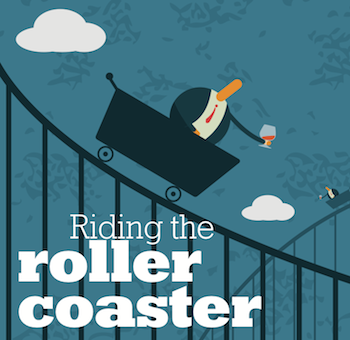................................................................................................................................................................................
 FOR THE NTH TIME IN ITS 300-YEAR ROLLER-COASTER HISTORY THE COGNAC TRADE IS
FOR THE NTH TIME IN ITS 300-YEAR ROLLER-COASTER HISTORY THE COGNAC TRADE IS
EXPERIENCING A STOMACH-CHURNING DOWN-DRAUGHT, ALMOST ENTIRELY DUE TO A SLUMP IN SALES TO CHINA. In the previous decade the country had witnessed the most extraordinary transformation in cognac’s long history. When Mao died fewer than 40 years ago a mere 350 bottles of cognac were sold there. As recently as 2004 only 3.7m bottles were sold, representing under 3% of the value of total sales. Yet by 2012 nearly
25m bottles were sold representing a full 18% of total value (BNIC).
This made China second only in sales to the US but it was by far the most profitable per bottle since the Chinese disdain the cheap VS grade, preferring the more expensive VSOP and, above all, the seriously dear XO and the fancier cognacs which sell at prices in the thousands of pounds. But this was a peak – in 2013 they were town to 20m, a ‘mere’ 15%, and last year down to 15m, a tenth of the total.
The reason generally provided is the clampdown on luxury entertaining by a government newly serious in its campaign against corruption, similar to one that resulted in a temporary slump 15 years ago. The slump was probably exacerbated by a lot of overstocking and it is quite likely that sales – except perhaps of the truly luxury brands such as Rémy Martin’s Louis XIII – will soon resume their upward climb.
For today sales are not confined to an exhibitionist elite but have become a relatively everyday item in the shopping of China’s ever-expanding middle classes. So it is unlikely that cognac will suffer as badly as it did when the market in Japan, another consumer of the finer brandies, virtually shut down in 1990 and has never really recovered.
In fact, the slump may help cognac in providing breathing space allowing the region to rebuild its stock of ageing cognacs. This had proved totally inadequate during the boom years because during the bad years of the 1990s the growers had managed to force production down severely, by reducing the amount of brandy that could be distilled.
long-term survival
But cognac – like scotch – remains a volatile business so it takes iron nerves, considerable financial backing, or truly exceptional products to ensure long-term survival. As a result the four major producers – Hennessy, by far the biggest, Rémy Martin, Martell and Courvoisier – now control around 85% of total sales. All, notably except Rémy, are subsidiaries of major global groups – LVMH, Pernod Ricard and Beam Suntory. For them cognac is a relatively niche business given that total production, a mere 15m cases, is much the same as a couple of major brands of scotch or vodka.
But the global firms appreciate the uniqueness of Cognac, it’s the biggest producer of brandies from grapes, a far more complex raw material than the grain which is the basis of whiskies.



